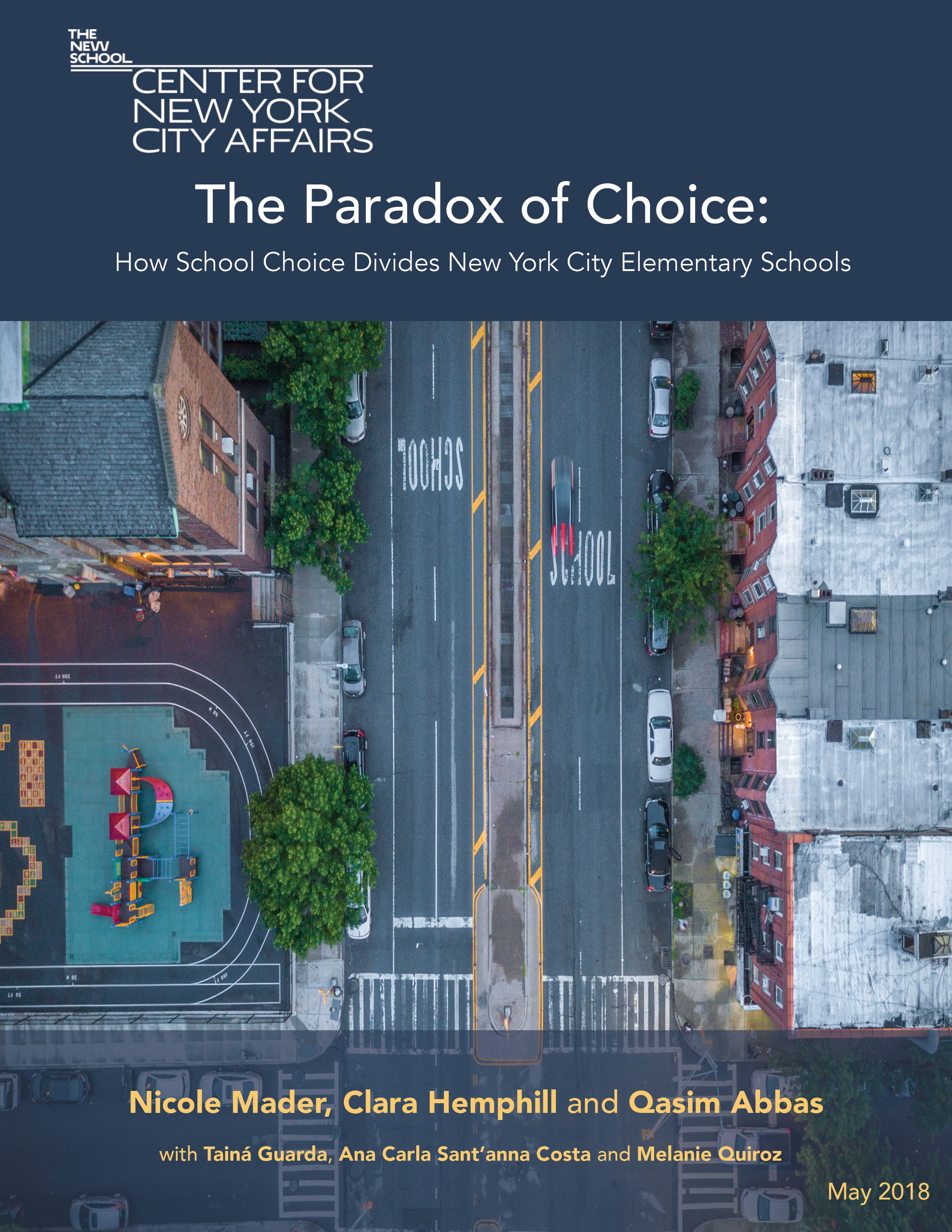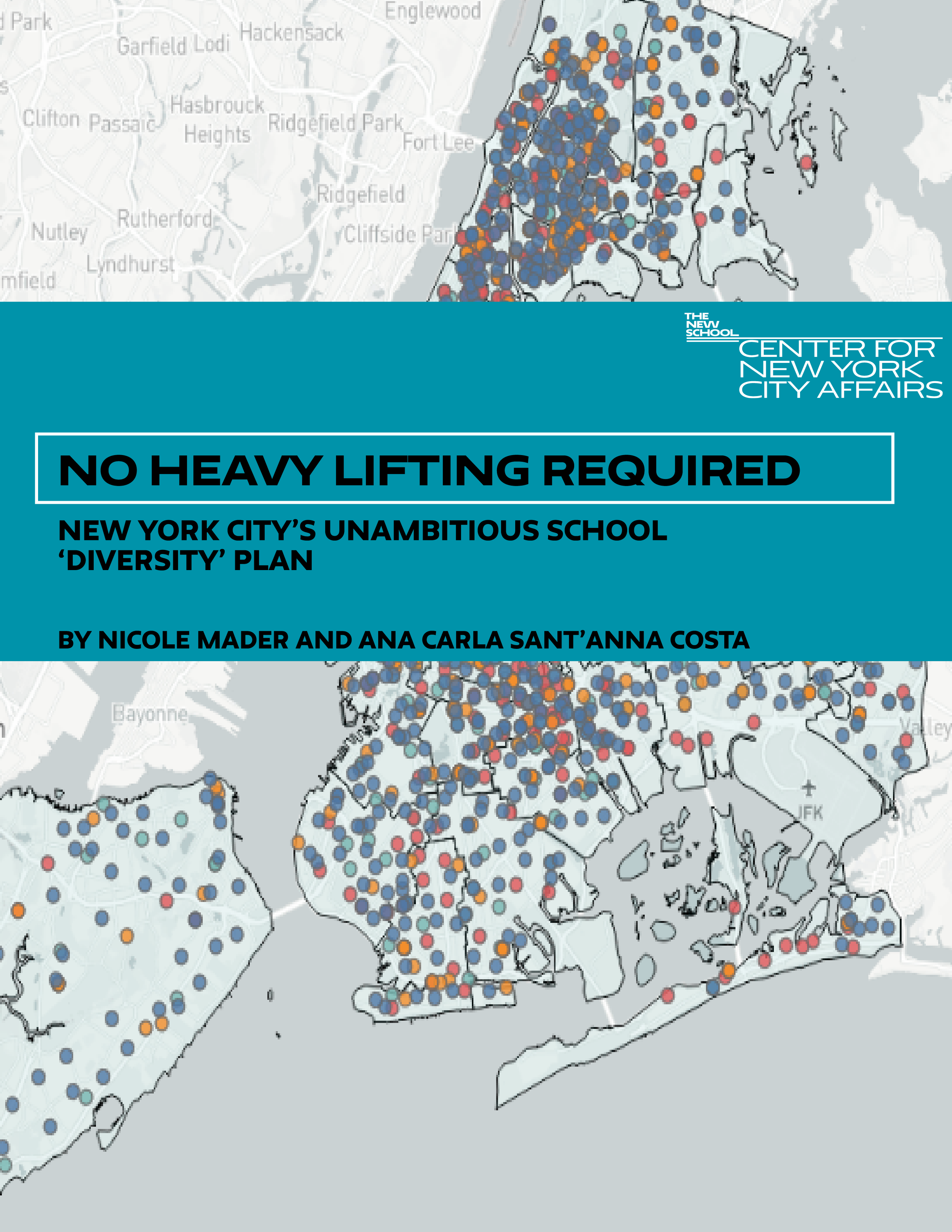By Nicole Mader, Melanie Quiroz, and Carmen Cheung
Mayor Bill de Blasio’s proposal to end use of the Specialized High School Admissions Test (SHSAT) would make the city’s most elite public high schools more racially and ethnically diverse. The mayor’s plan would instead offer seats at the specialized high schools to the top performers in each of the city’s public middle schools. We tested this proposal and found that, if enacted, it would give some 2,000 academically qualified Black and Latinx students each year access to higher-performing schools and a more ethnically diverse cohort of fellow students than they typically have through the current school choice process.
Report
Screened Schools: How to Broaden Access and Diversity
By Clara Hemphill, Nicole Mader, Melanie Quiroz, and Laura Zingmond
Nearly 15% of New York City public high school students and about 18% of middle school students attend academically “screened” schools that rely on such factors as student grade point averages and standardized test scores for admission. Some educators and activists believe that screens reinforce racial and social privilege and should be abolished. “Screened Schools” addresses this subject and suggests a range of practicable strategies for increasing both diversity and educational quality in schools across the city.
Report
Promising Outcomes, Limited Potential: Diversity In Admissions In New York City Public Schools
By Nicole Mader, Abigail Kramer, Angela Butel
In 2016, New York City rolled out a small pilot project intended to address a problem that many in the city had long ignored or taken for granted: While New York’s public school population is one of the most diverse in the country, it is also one of the most starkly segregated by race and class. In a report, released by the Center for New York City Affairs, we assess the promises and limitations of the Diversity in Admissions initiative, as well as its outcomes so far. Using school- and grade-level data for each of the pilot schools, we created the interactive visualizations below to understand all 86 schools’ goals in the context of recent trends in the demographic makeup of their student populations. We spoke with school leaders, DOE administrators, and academic researchers to learn how these schools designed their admissions priorities and the challenges they’ve faced in implementing them. And we analyzed results at the 19 schools that participated in the initiative’s first two years.
Mayor Bill de Blasio faces an uphill battle in Albany in his quest to get rid of the admissions test for elite high schools including Stuyvesant and Bronx High School of Science, but there’s a lot he can do now to advance his Administration’s stated goal of increasing opportunities for talented black and Latino kids—without the approval of the State Legislature.
In the mostly pessimistic debate over school segregation here’s a reason for optimism: For the first time in decades, we have the possibility — if not yet the reality — of more economically, and also racially, integrated public schools in many neighborhoods in New York City. And there are heartening examples at the grassroots level of parents and school principals working toward that goal.
The Paradox of Choice: How School Choice Divides New York City Elementary Schools
By Nicole Mader, Clara Hemphill, and Qasim Abbas, Taina Guarda, Ana Carla Sant’anna Costa, and Melanie Quiroz
The conventional wisdom is that most elementary school children in New York City attend their zoned neighborhood schools and that the city’s high levels of school segregation merely reflect segregated housing patterns. But a more nuanced and in some ways disquieting story emerges from our analysis presented in a new policy report from the Center for New York City Affairs, “The Paradox of Choice.”
The Calculus of Race and Class: A New Look at the Achievement Gap in New York City Schools
By Nicole Mader and Ana Carla Sant’anna Costa
Decades of national research have documented the “achievement gap” among students of different racial and ethnic groups as measured by their scores on standardized tests, with White and Asian students generally outperforming their Black and Hispanic peers. Now, a new tool developed by the Integration Project at the Center for New York City Affairs allows parents, educators, and policymakers to see just how large that gap is among students at each of the city’s approximately 900 public elementary schools, both district and charter. It also shows how strongly and how frequently this gap is moderated by the household incomes of students, even within the same schools.
Brief
No Heavy Lifting Required: New York City's Unambitious School 'Diversity Plan
By Nicole Mader and Ana Carla Sant'Anna Costa
Earlier this month, the New York City Department of Education (DOE) released a long-awaited plan designed to increase diversity in the city's public schools. The Center for New York City Affairs has crunched the numbers on these goals and found that they would not reflect meaningful, systemic change.
URBAN MATTERS
The Fierce Urgency of Now: Five Steps to Integrate New York City Elementary Schools
By Clara Hemphill, Lydie Raschka, and Nicole Mader
In the past year, New York City officials have taken small steps to ease racial and economic integration of enrollment in several dozen of the city’s 955 public elementary schools. In August, Mayor Bill de Blasio promised a “bigger vision” focused on such efforts. To date, however, his administration has yet to come up with a plan for larger-scale efforts to diversify enrollment among the city’s notoriously segregated schools.
REPORTS
Five Steps to Integrate New York City Elementary School (2016)
By Clara Hemphill, Lydie Raschka and Nicole Mader
The City can do much more to foster economic integration of elementary schools than the small scale efforts it has made to date. Based on our visits to 150 schools across the city over the past two years, here are five feasible steps we believe the City can take.
Urban matters
West Side Story: How City Leaders Can Back a Brave School Zoning Plan (2016)
By Clara Hemphill
After two years of contentious public meetings, the Community Education Council, an elected panel of parents, has come up with a courageous and long overdue plan to ease overcrowding and foster racial and economic integration of three elementary schools in District 3 on Manhattan’s Upper West Side. It is a bold attempt to balance competing interests and to resolve one of the city’s most intractable social problems.
READ MORE
REPORTS
Integrated Schools in a Segregated City: Ten strategies that have made New York City elementary schools more diverse (2016)
Reports
Segregated Schools in Integrated Neighborhoods: The City's Schools Are Even More Divided Than Our Housing (2016)
By Clara Hemphill and Nicole Mader
In multi-ethnic New York City, why are so many elementary schools segregated by race and class? New research demonstrates that school segregation is not always the result of housing patterns.
Urban Matters
Diversity in New York’s Specialized Schools:
A Deeper Data Dive
The most recent Urban Matters reported on patterns of racial and ethnic admission to some of the city’s most prestigious secondary schools and how admissions might more closely mirror the overall composition of the city’s public schools.
READ MORE
Tough Test Ahead: Bringing Racial Diversity To New York’s Specialized High Schools
There’s a longstanding debate about why so few Black and Hispanic students are admitted to New York City’s specialized high schools, including Stuyvesant, Bronx Science, and Brooklyn Tech. They accounted for fewer than 9% of students offered admissions at eight specialized schools for the current school year; that’s down from 9.6% the year before. We analyzed the numbers.
Can 'Controlled Choice' Help Integrate NYC Schools?
“Controlled choice” as a way to ease racial and economic segregation in elementary schools is a current hot topic on Manhattan’s Upper West Side. The idea, proposed by a group called District 3 Task Force for Education Equity and now up for consideration by education decision-makers, is to get rid of school attendance zones and assign children to schools according to a formula that takes into account parent preferences as well as family income.
Are Schools Segregated Because Housing Is? It Ain’t Necessarily So
In multi-ethnic New York City, why are so many elementary schools segregated by race and class? For years, school officials and researchers have assumed that school segregation merely reflects segregated housing patterns—because most children attend their zoned neighborhood schools.
However, new research demonstrates that school segregation is not always the result of housing patterns. In fact, as these interactive maps show, there are dozens of high-poverty elementary schools that serve mostly black and Latino children that are located in far more racially and economically mixed neighborhoods.
Articles
Let Rich and Poor Learn Together (2015)
By Clara Hemphill and Halley Potter (New York Times)
THE mayor of New York City, Bill de Blasio, campaigned on a promise to provide free universal pre-K classes to more than 70,000 4-year-olds. The city is now poised to meet this ambitious goal.



















